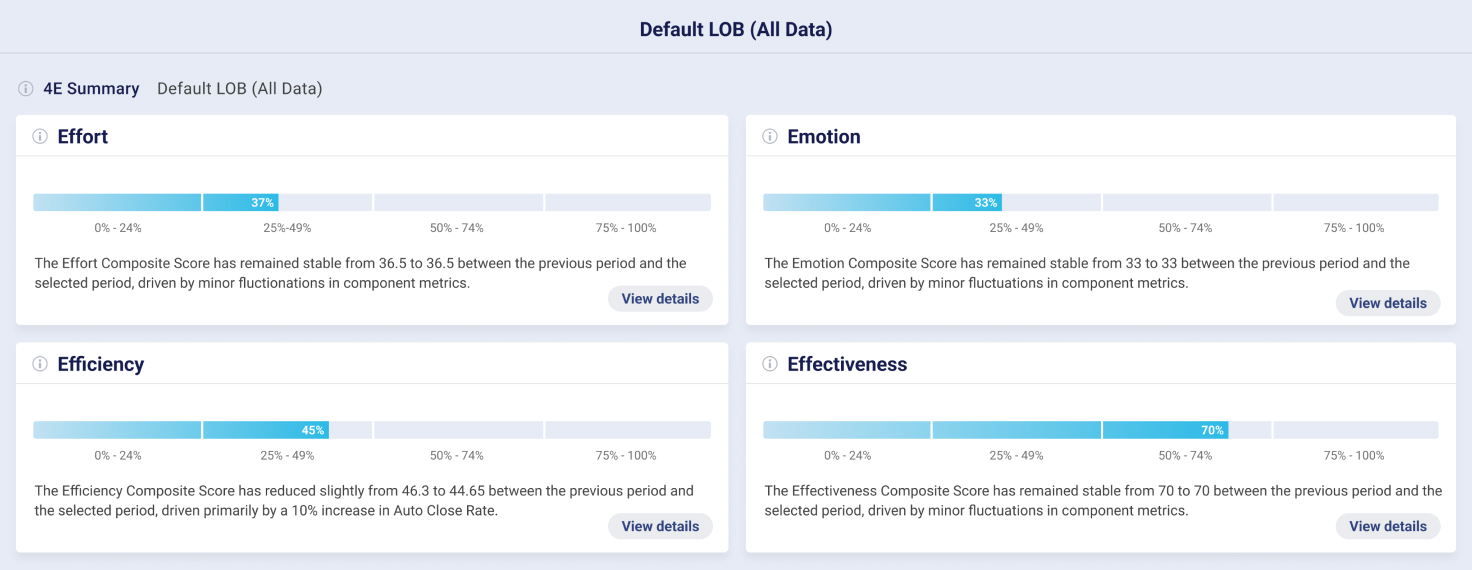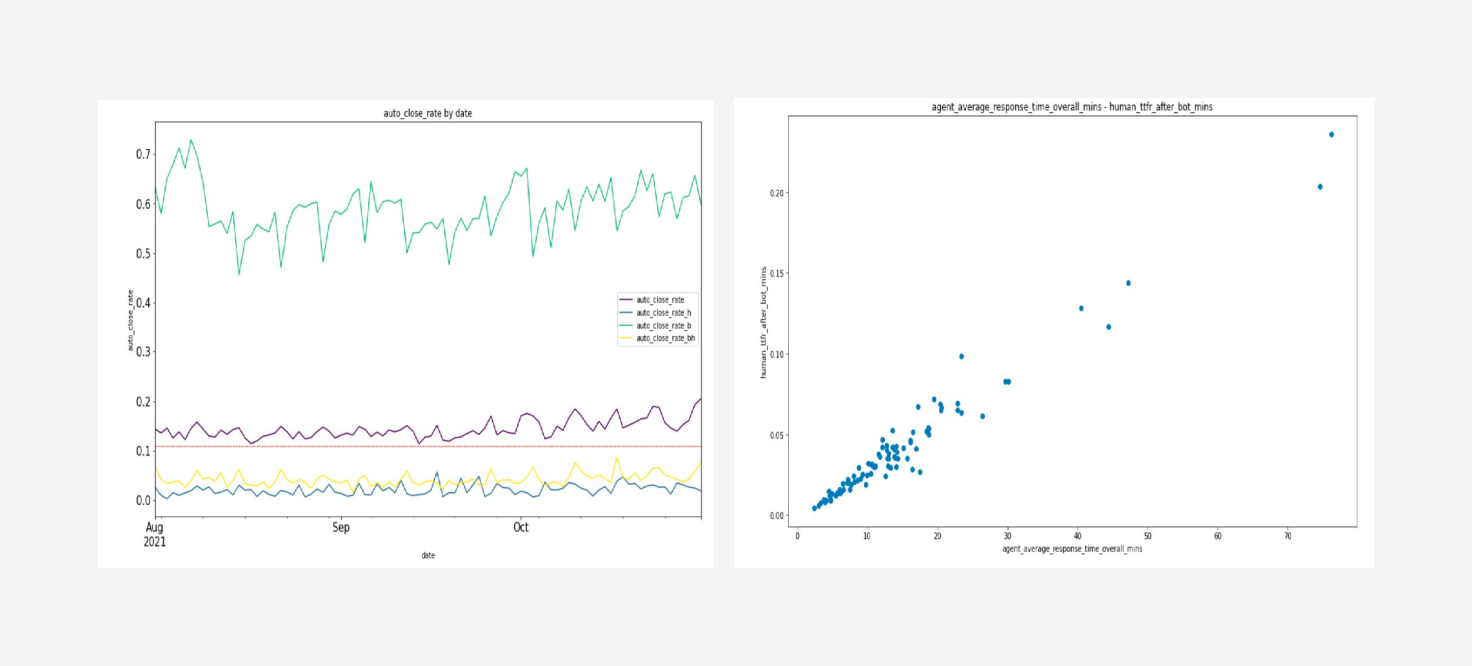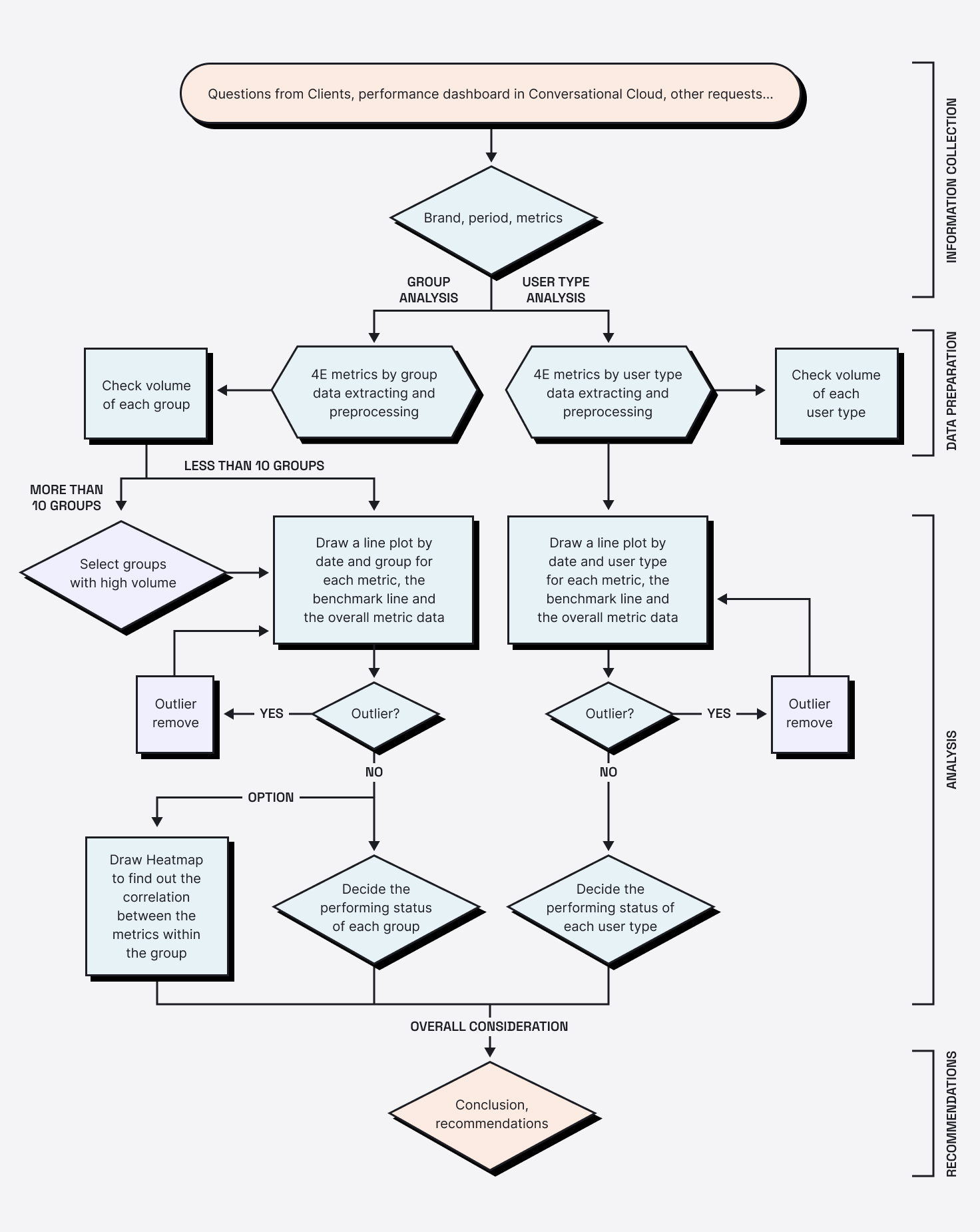article
How to leverage the 4E Framework for conversational AI analytics
How LivePerson’s proprietary 4E metrics provide actionable insights essential for conversational and operational performance improvement
August 23, 2022 • 7 minutes

From the outside, conversational AI analytics — like natural language processing and AI solutions — can seem shrouded in mystery. Especially when it comes to setting goals and measuring success accurately. But LivePerson’s 4E Framework makes effectively managing conversational performance possible.
What is the 4E Framework?
The 4E Framework is a comprehensive approach to evaluating conversational AI performance. It focuses conversational analytics around four E’s: Efficiency, Effectiveness, Effort, and Emotion. It goes beyond traditional metrics to analyze both the operational efficiency and the resulting customer experience.
Currently, 4Es consist of 22 metrics to measure the brand performance and consumer experience across all brands. It helps companies improve performance and efficiency, which drives reduced labor costs to save money.
Benefits of the 4E Framework in measuring conversational and chatbot performance
The 4E Framework revolutionizes how businesses approach customer experience with the power of conversational AI and chatbots. Built on the core principle that exceptional experiences require efficient and effective operations, it offers several key benefits:
- Universal relevance: Applicable across all industries and brands, the 4E Framework transcends specific customer conversations. In 2024, many brands are leveraging 4E to gauge the success of their conversational strategies.
- Outcome-oriented focus: It prioritizes and streamlines existing metrics, highlighting the ones that truly matter for customer interactions. This eliminates metric overload and ensures focus on what drives results.
- Future-proof design: The 4E Framework serves as a foundational block for future development of tools dedicated to operational optimization within the conversational AI landscape.
How to use the 4E Framework to maximize business operations
LivePerson’s proprietary 4E metrics use a simple format to improve business operations, though it may not sound simple. With it, we build a performance diagnostic process system to maximize value. The process is generalized so it can be easily adopted across brands, identifying the improvement opportunities by pinpointing where issues come from, leading to a recommended action in line with business goals.
Let’s take a look at how this performance diagnosis through data insights works.
1. Gaining insight through the 4Es

4E metrics introduce general insights to measure performance. Shown in the graph above, we can track conversation insights and trends in a timeframe or a specific time point for a specific brand to understand where their 4E metrics are standing compared to the industry benchmark. These insights raise further questions of “what,” “why,” and “how”:
- What creates the low efficiency? Why are the metrics off target? How can we improve?
- What is the reason for the poor customer experience that leads to low emotion metrics? How do we handle this with employees and/or processes?
- How do I compare against my industry peers? How can our team implement optimization tactics to eliminate weak spots and become best in class?
2. Analyzing and diagnosing conversational and chatbot performance
To answer the above questions, we conduct a diagnostic analysis. Data segmentation and the metrics correlation analysis are the core of the diagnosis. Based on the conversation operation and management, the data can be segmented in different ways:
- Vertical
- Industry
- Region
- Agent group
- Intent
- Skill
The segmentation can be parallel or across from each other with multiple levels. We compare the 4E metrics between the segmented group and find the correlation between metrics in different segment levels.

Through this process, we are able to answer the “what” and “why” questions in relations to customer interactions. For example, we could identify the intent or line of business that is not performing as expected. Perhaps we come to understand that a metric’s poor value is caused by the correlation with other metrics, helping resolve small or big issues.
3. Data-based recommendations
Finally, we draw a conclusion based on the diagnostic analysis above and provide recommendations to pinpoint the root cause. Brands are able to significantly reduce the cognitive load of analysis and create some improvement plans, helping them achieve business goals and potentially cut costs with improved productivity.
The best application of the 4E Framework
The 4E Framework offers a unique advantage compared to traditional metrics focused solely on model performance. While precision and recall are valuable, they don’t capture the complete picture of how conversational AI impacts your business. Here’s when the 4E Framework comes into play:
Driving operational excellence
Imagine a contact center churning through inquiries efficiently (high Efficiency) but failing to resolve customer issues (low Effectiveness). The 4E Framework exposes this gap, allowing you to optimize resource allocation strategies and training to achieve both speed and successful resolutions, ultimately boosting ROI and customer satisfaction.
Benchmarking for competitive advantage
The 4E Framework transcends internal evaluation. By benchmarking your 4E scores against industry and regional competitors, you gain valuable insights into your competitive landscape and market trends. Are you delivering the most Effortless experience? Does your Effectiveness in achieving sales goals surpass rivals? This data pinpoints specific areas for improvement, guiding you toward becoming the best-in-class customer service provider.
Optimizing AI chatbot implementation
AI chatbots and automation are powerful tools for boosting contact center efficiency. However, neglecting the other E’s can lead to a negative customer experience. The 4E Framework ensures a balanced approach. You can measure efficiency gains alongside effectiveness (are chatbots resolving issues?), effort (is interaction smooth?) and emotion (are customers frustrated?). This ensures a positive impact on the customer journey, even with automation in place.
Performance diagnosis workflow example

In essence, the 4E Framework provides a powerful roadmap for success in the conversational AI landscape. It offers a comprehensive approach, prioritizes outcomes and resources and leverages automation to streamline operations and deliver exceptional customer experiences.
FAQs
Traditional customer experience (CX) metrics, like Customer Satisfaction (CSAT) scores, often paint a one-dimensional picture. They tell you if a customer is happy or not, but they don’t delve into the “why” behind the sentiment. The LivePerson 4E Framework differentiates itself by offering a holistic approach. It considers not just the outcome (satisfaction) but also the journey itself, providing a more nuanced understanding of how well the chatbot is performing. This increased knowledge allows for targeted improvements that address specific pain points within the customer interaction, ultimately leading to a more positive overall experience.
While primarily designed for AI chatbot use, the 4E Framework can be applied to evaluate live agent performance as well. By analyzing metrics like call resolution time, customer satisfaction with agents and effort required to resolve issues, you can gain valuable insights into the overall customer experience, encompassing both chatbots and live agents.
No. In digital marketing on social media platforms, the 4E framework focuses on building a brand and audience engagement, whereas LivePerson 4E Framework is specific to evaluating the performance of chatbots in customer interactions. Here’s a breakdown of the key differences:
Social media marketing / digital marketing 4E’s
– Educate: Inform target audience.
– Engage: Build customer engagement.
– Entertain: Create content / capture attention.
– Empower: Build brand loyalty.
LivePerson chatbot metrics 4E’s
– Efficiency: How well the AI chatbot handles inquiries.
– Effectiveness: How well the chatbot achieves its goals.
– Effort: How easy it is for the customer to actively engage with the chatbot.
– Emotion: The customer’s sentiment during the interaction.
Overall, the 4Es in social media marketing are about growing interested followers and customer engagement, while the 4Es of LivePerson chatbot metrics are about ensuring the chatbot delivers a smooth and effective customer experience.

